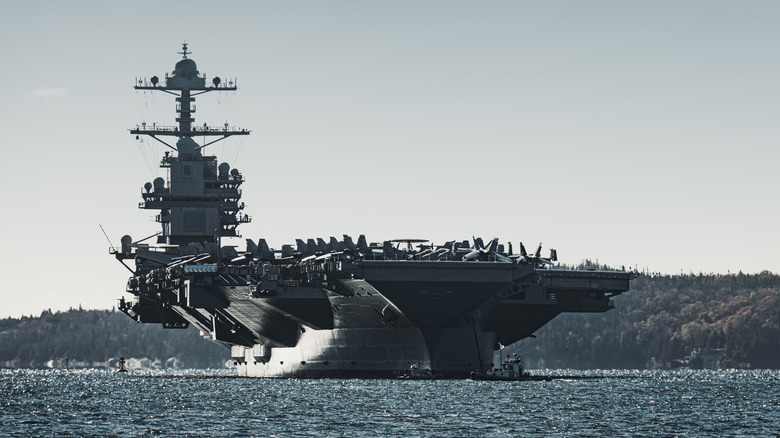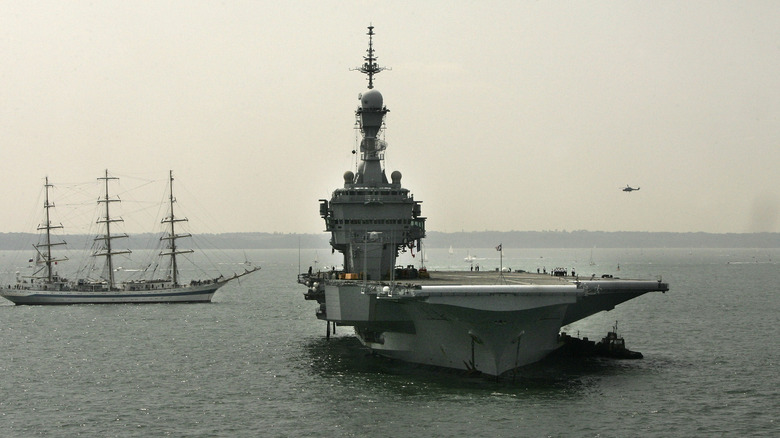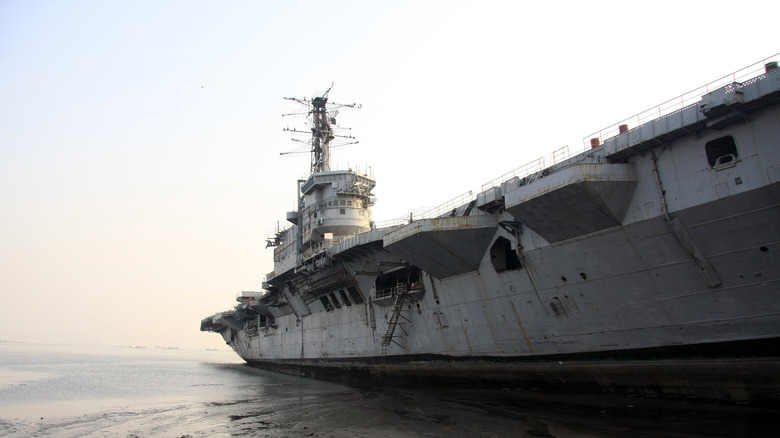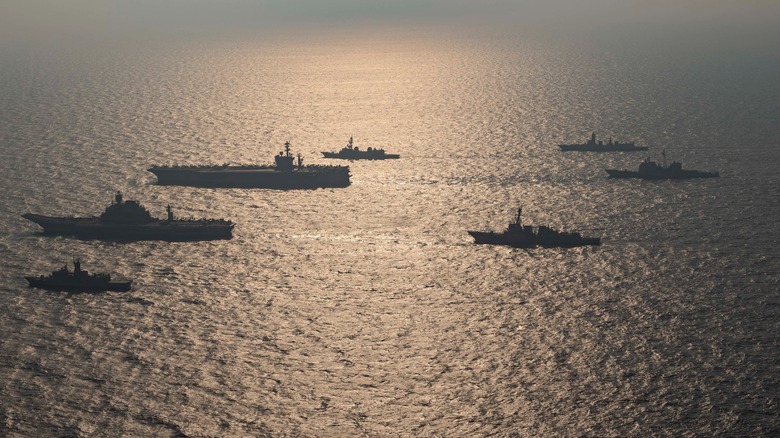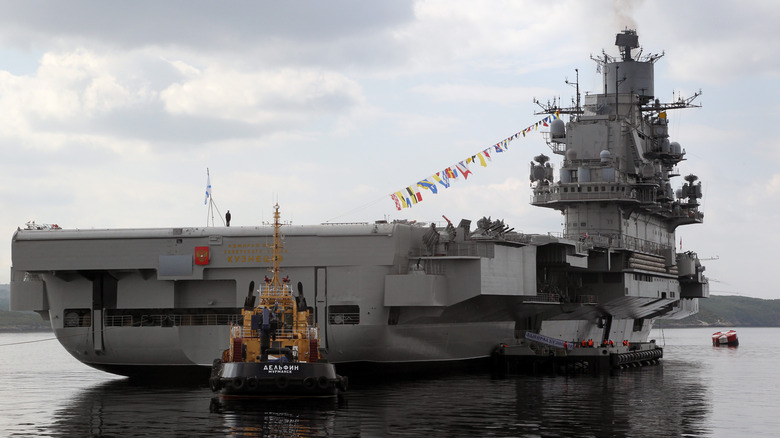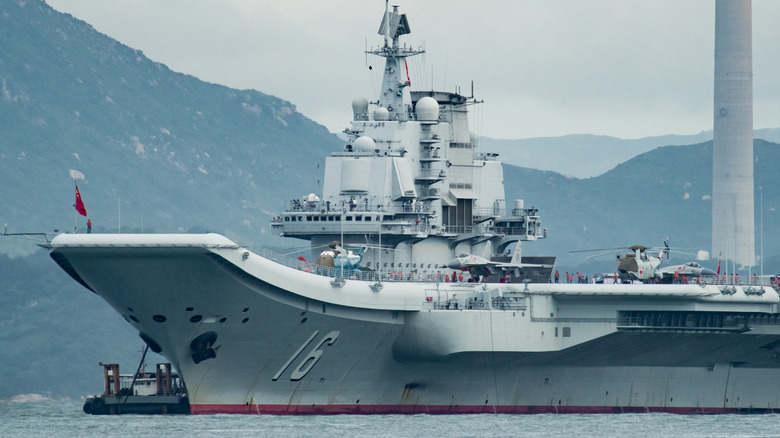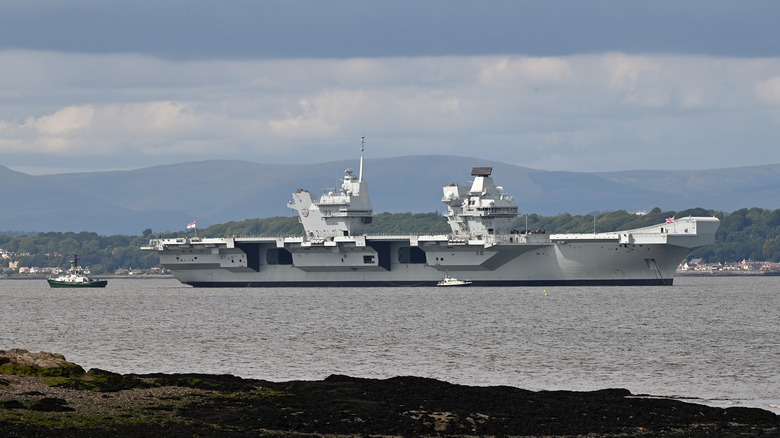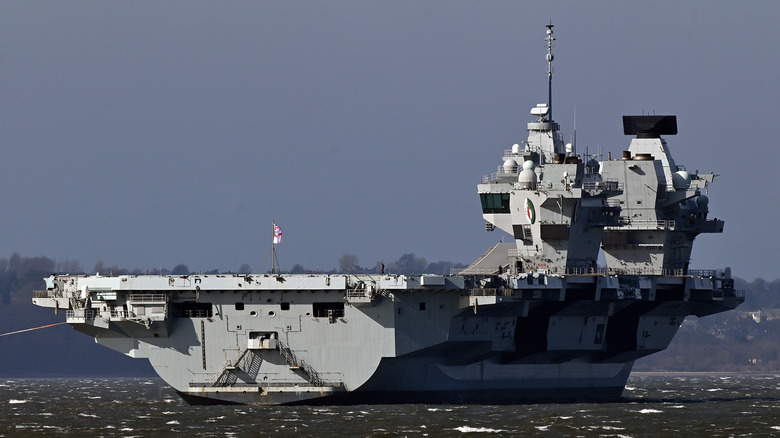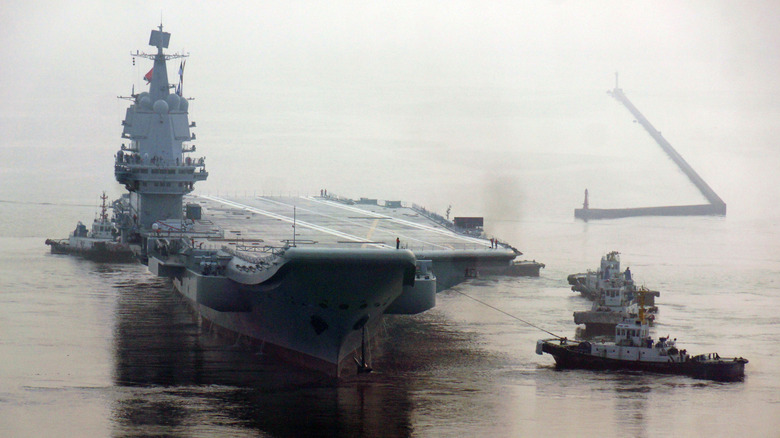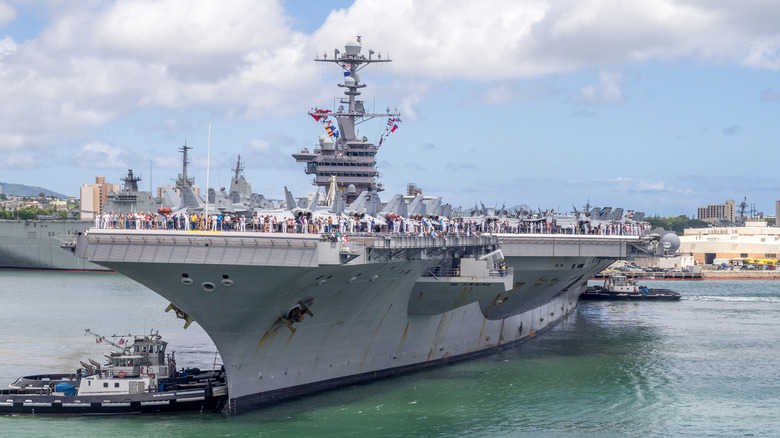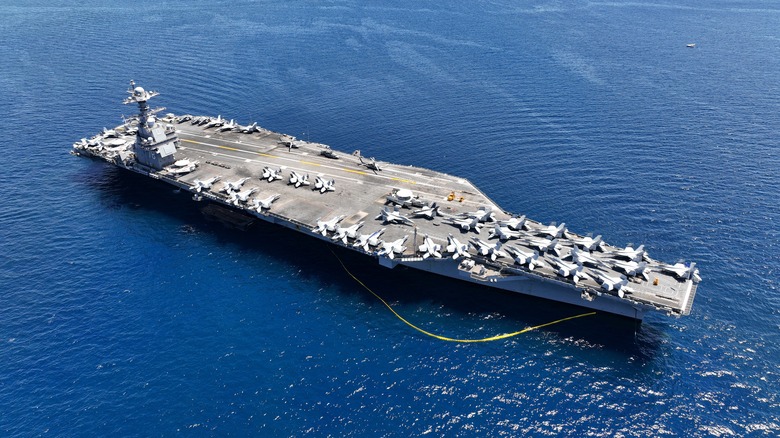10 Of The Biggest Aircraft Carriers In The World
Ever since aircraft started to play a more vital role in warfare, aircraft carriers have become increasingly important. These massive ships are often some of the largest in a navy, and they allow countries to project their air power to any part of the world without establishing permanent air bases. In fact, they effectively operate as mobile floating air bases that can carry dozens of fighter jets and helicopters. That's not even taking into account the thousands of crew and hundreds of troops these vessels also transport across the sea.
Obviously, aircraft carriers have to be pretty large to hold all the equipment, fighters, and helicopters on the flight deck. They also need a runway to provide enough space for these vehicles to take off and land safely. The huge size of aircraft carriers might even make you wonder how they stay afloat.
Even small aircraft carriers dwarf other naval vessels and some of these examples can make other ships seem tiny in comparison. Here are 10 of the biggest aircraft carriers currently in existence.
FS Charles de Gaulle - 42,500 tons
The FS Charles de Gaulle is a French aircraft carrier that acts as the flagship of the French Navy. Named after former general and president Charles de Gaulle, it is a nuclear-powered vessel, making it the only such ship in the world not in the service of the United States Navy. This effectively allows it to remain at sea for an unlimited amount of time, with the only factor limiting its range being the amount of food that it has onboard.
The aircraft carrier was ordered in 1986 and laid down in 1989. However, a lack of funding meant that the project was delayed several times as the price eventually rose to more than 3 billion euros. This included the need to extend the flight deck to safely accommodate aircraft that would land and take-off from the vessel. After finally entering service in 2001, the FS Charles de Gaulle has suffered from a number of technical issues over the last two decades.
The ship can carry more than 1,300 people and several dozen aircraft, ranging from fearsome fighter jets like the Rafale M to larger E-2C Hawkeye twin-turboprops. It can also deploy the AS365F Dauphin Pedro helicopter. The FS Charles de Gaulle stands at 858 feet long, 218 feet high, and has a displacement of 42,500 tons.
INS Vikrant - 45,000 tons
The INS Vikrant may not be as well known as some aircraft carriers from Western powers, but it is still a significant ship. The Indian Navy's fourth aircraft carrier was the first to be built entirely in India, having been laid down at Cochin Shipyard Limited in Kerala. The carrier was ordered in 2004 and saw construction begin five years later in 2009. The launch of the ship followed in 2013 and it entered service in 2022, becoming one of two active aircraft carriers in the Indian Navy.
The size of the INS Vikrant puts it among the largest in the world. It can displace 45,000 tons of water and is capable of transporting up to 30 fixed-wing aircraft and helicopters. That's largely due to the fact that it is 860 feet long and over 190 feet high. Powered by four General Electric LM2500 gas turbines, it can travel at speeds of up to 35 mph and has a range of over 9,000 miles.
Vikrant translates into English from Sanskrit as "courageous" and the ship's motto is: "I defeat those who dare to challenge me." These aren't entirely fanciful boasts. The aircraft carrier is armed with legendary naval aircraft such as the MiG-29K, along with Kamov Ka-31 and MH-60R helicopters. Of course, it also has air defenses of its own, including a stock of Barak 8 surface-to-air missiles and the automated AK-630 rotary cannon.
INS Vikramaditya - 45,400 tons
Unlike India's other aircraft carrier, the INS Vikramaditya was not purpose built for the Indian Navy. In fact, the ship has a long history and dates back to the 1980s, where it was built and put into service by the Soviet Union. Officially entering service in 1987 under the name Baku, the ship was renamed Admiral Gorshkov in 1991 but was decommissioned just five years later due to expensive running costs.
This prompted negotiations with India over the sale of the aircraft carrier, with the Russian government agreeing in 2004 to give India the ship itself for free, although India would pay Russia's Sevmash shipyard nearly a billion dollars to upgrade the ship for the Indian Navy's needs. Cost overruns and several delays meant that the ship did not enter service in the Indian Navy until 2013, by which time the total price of the deal had exceeded $2 billion.
By the time that the INS Vikramaditya entered service, it was significantly larger and heavier than it was as the Baku in the Soviet Navy. Modifications were made to update the overall design of the vessel to allow for new systems and sensors. Meanwhile, the configuration of the flight deck was switched so that it could launch Mikoyan MiG-29K fighters as well as Westland Sea King helicopters, in addition to a number of other aircraft. At 932 feet long, the INS Vikramaditya has a loaded displacement of 45,400 tons, slightly more than the INS Vikrant.
[Featured image by Official U.S. Navy Page via Wikimedia Commons | Cropped and scaled | CC BY 2.0]
Admiral Kuznetsov - 58,000 tons
The Admiral Kuznetsov is a Russian aircraft carrier that has been in service since 1991, although the vessel didn't actually become fully operational until four years later in 1995. Commissioned alongside a second carrier in 1981, it was the only ship that was near completion when the Soviet Union was dissolved. It was built in Ukraine and eventually become the flagship of the Russian Navy. However, the Admiral Kuznetsov has been undergoing repairs and upgrades that have kept it out of action since 2018 amid complaints of corruption, incompetence, and significant delays.
This aircraft carrier has a displacement of 58,000 tons but can be configured to have a displacement of just 43,000 tons when it is at its lightest. It can carry Sukhoi Su-33 and MiG-29K fighters in addition to helicopters such as the Ka-31 and Ka-27.
Unlike aircraft carriers employed by other nations, the Admiral Kuznetsov is designed to fulfill a cruiser role. That means it comes equipped with a more powerful armament that includes 12 surface-to-surface missiles and a Klinok air defense missile system. However, the vessel is considered outdated by many and is powered by more archaic engines than most aircraft carriers, which means it leaves a large black smoke trail behind it when it sails.
Liaoning - 60,000 tons
The Liaoning is a Chinese aircraft carrier that is currently in service in the People's Liberation Army Navy, although it was not originally built for China. It was laid down in 1985 and was under construction alongside the Admiral Kuznetsov in Ukraine. Then known as the Riga, it was further behind its sister and not yet completed by the time of the dissolution of the Soviet Union in 1991. Ukrainian authorities stripped down the hull and eventually sold the vessel to China for use as a training ship, although it has since been converted into a active combat ship.
The upgrades and updates applied to the Liaoning to make it combat-ready have improved its capabilities while also increasing its overall weight and size. This means it is notably larger than its sister ship that is still used by the Russian Navy, with a maximum displacement of 60,000 tons. However, it lacks the firepower of the Admiral Kuznetso, as it carries no cruise missiles or surface-to-surface weapons. Instead, it relies on its complement of Shenyang J-15 fighters to provide ground attack, as well as several different types of helicopters.
HMS Prince of Wales - 65,000 tons
Although the United Kingdom is not the naval powerhouse it once was, the Royal Navy is still a very prominent fleet — one that fields some of the most powerful navy destroyers in the world. It makes some sense, then, that it has aircraft carriers that are among the largest you can find on the globe outside of the United States and China. The HMS Prince of Wales is the second of two Queen Elizabeth-class aircraft carriers and began construction in 2011 after a standoff between the British government and BAE Systems.
The ship was nearly cancelled in 2010, when a government report found that having two aircraft carriers in the Royal navy was unnecessary. Prime Minister David Cameron only wanted to commit to building one aircraft carrier of this type but was persuaded to continue with the original plan after it was discovered cancelling the contract would lead to massive job losses and excessive cancellation fees. In fact, it would be more expensive to not move ahead with the project than it would be to actually build the ship.
HMS Prince of Wales utilizes a ski-jump ramp that is designed to launch aircraft such as the F-35B Lightning II variant and the AgustaWestland Merlin helicopter. It is almost 1,000 feet in length and displaces 65,000 tons at its maximum load.
HMS Queen Elizabeth - 65,000 tons
The fleet flagship of the Royal Navy is the HMS Queen Elizabeth. The sister ship to the HMS Prince of Wales, it bears the name of Queen Elizabeth I and entered service in 2017 after being first laid down in 2009 and then launched in 2014.
The HMS Queen Elizabeth is capable of carrying up to a maximum of 65 aircraft and helicopters, although will usually carry far fewer than this during normal operations. The aircraft on the flight deck will include up to 36 F-35B Lightning II fighter jets along with a variety of helicopters such as Chinooks, Apache AH MK1, and Merlin HM2s. That's in addition to the crew of some 1,600 that the ship can carry, along with 250 Royal Marines. The vessel itself has a range of 10,000 nautical miles and can travel at speeds of up to 37 mph.
The HMS Queen Elizabeth is equal in size to the HMS Prince of Wales. It is 932 feet long, has a draft of 36 feet, and can displace a total of 65,000 tons when fully loaded. There are also a total of nine decks in addition to the flight deck, providing a large amount of space for equipment and the crew.
Shandong - 70,000 tons
The Liaoning is not the only aircraft carrier in the People's Liberation Army Navy as the Chinese military also has the Shandong, a ship built by China rather than being purchased from a third party. That said, the Shandong might look familiar as it is simply a modified version of the Kuznetsov-class aircraft carrier that includes both the Admiral Kuznetsov and the Liaoning. Construction began in 2013 when the ship was laid down and it is the work of the Dalian Shipbuilding Industry. China kept the existence of the project a secret during much of its construction, only providing official confirmation that it was building an aircraft carrier in 2015.
The Shandong stands at a little over 1,000 feet long and can displace between 60,000 and 70,000 tons depending on its load and configuration. The larger overall size of the Shandong compared to the Liaoning is down to the fact that the more recent aircraft carrier is more dedicated to flight operations. This allows it to carry more aircraft than its predecessor, with room for up to 44 jet fighters and helicopters on the flight deck, including Shenyang J-15 fighters and Changhe Z-18s. There are also suggestions that it may also be able to deploy the Shenyang FC-31 stealth fighter, otherwise known as the J-35.
Nimitz Class - 97,000 tons
Compared to other nations, the United States has a far larger fleet of aircraft carriers. Listing individual ships would mean that the entire article would be taken up with aircraft carriers from a single class, all of which have essentially the same design and appearance. The Nimitz-class is a good example of this, with the U.S. currently having 10 active vessels of this class in operation. All of these vessels were built by the Newport News Shipbuilding Company, with construction beginning with the USS Nimitz in 1968 and ending with the completion of the USS George H.W. Bush in 2006.
The Nimitz-class utilizes nuclear power in the form of water reactors for propulsion and was designed to replace both the Kitty Hawk-class and the Enterprise-class. There are two A4W nuclear reactors that drive steam turbines, allowing the aircraft carrier to reach a speed of 35 mph despite its huge size. The ship also makes use of arrestor wires and steam catapults to launch fighter jets and assist them with landing.
The Nimitz-class aircraft carriers can house a large number of aircraft. These range from F/A-18E or F Super Hornets, F/A-18C Hornets, EA-18G Growlers, C-2 Greyhounds, and HH-60H Seahawks. The ships are almost 1,100 feet long, have a draft of 37 feet, and displace an estimated 97,000 tons.
USS Gerald R. Ford - 100,000 tons
Prior to the launch of the USS Gerald R. Ford, the Nimitz-class aircraft carriers were the largest naval ships in the world. That all changed in 2017 when this Gerald R. Ford-class was commissioned and entered active service. Estimated to have cost $12.9 billion to construct, along with almost $5 billion of research and development for the entire class, the USS Gerald R. Ford is the first of 10 planned aircraft carriers that will eventually replace the Nimitz-class carriers already in service. That means the entire project will cost more than $120 billion.
In many ways, the Gerald R. Ford-class aircraft carriers are similar to the Nimitz-class. They have the same basic shape and structure but with a variety of upgrades and updates to sensors, systems, and equipment to make them suitable for modern warfare. These include advanced arresting gear, an electromagnetic aircraft launch system, and an updated version of the RIM-162 Evolved SeaSparrow Missile launcher.
The USS Gerald R. Ford is 1,106 feet long, 250 feet tall, and has 25 decks. It can also displace more than 100,000 tons. Like its predecessor, this aircraft carrier is nuclear powered with two Bechtel A1B nuclear reactors. This allows the ship to carry up to 75 aircraft, including everything from F-35 Joint Strike Fighters to F/A-18E Super Hornets.
